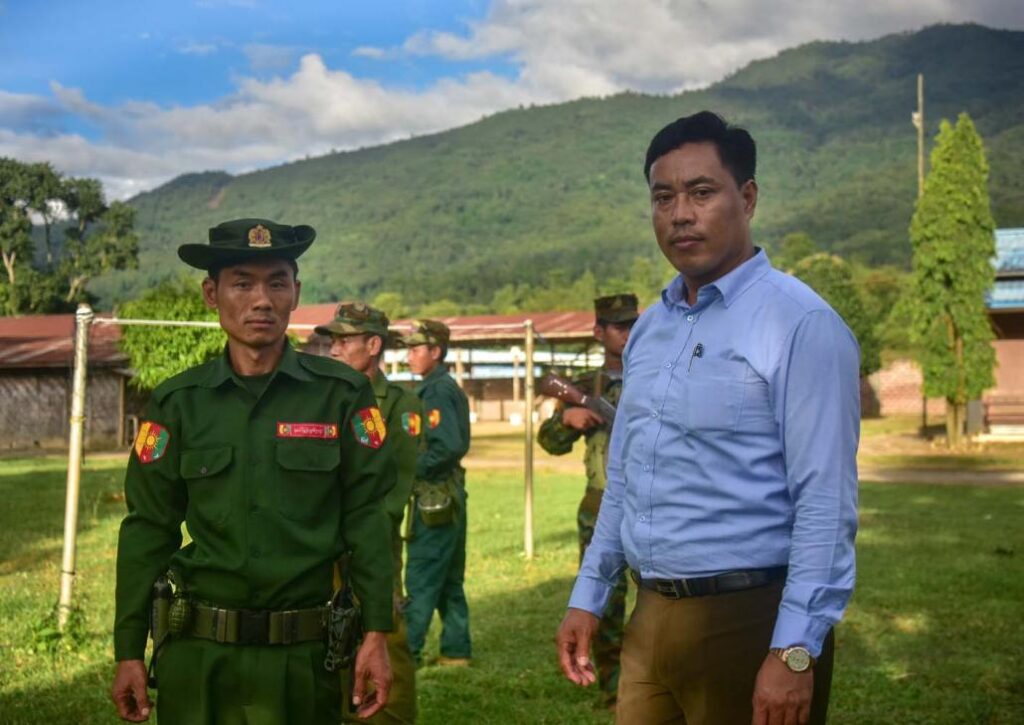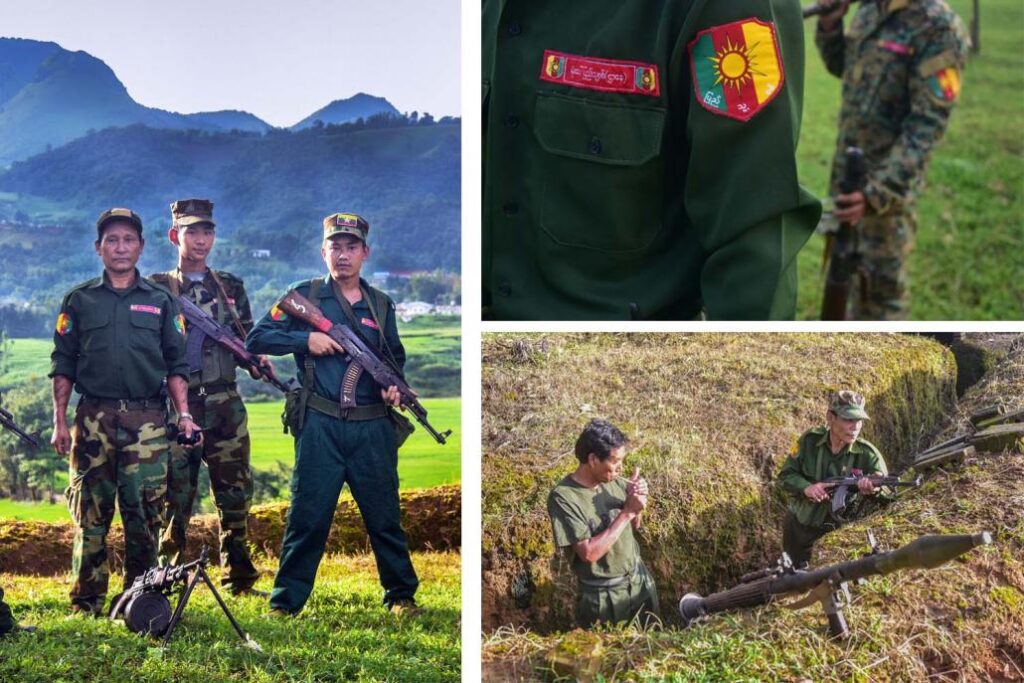Conflicts between ethnic armed organizations (EAOs) and the military regime seem to possess a significant spot in the complex web of conflicts that exist in Myanmar. However, the People Militia Force (PMF), locally known as Pyithusit are equally influential actors that have yet to gain attention.
These groups actually, dispersed across the country particularly in Shan State, function with implicit backing from the Myanmar military, serving as its covert instrument in maintaining authority and advancing its objectives.
Also, their strength is huge which can range from a few hundred to over a thousand personnel. Therefore, the militias have been playing pivotal roles in Myanmar’s ongoing armed struggles. These groups include a myriad of factions as shown in the table below:
Some of the well-known PMFs in Shan State:
| North | South | East |
| (1). Myo Ma, (2). Pan Say, (3). Nam Kham, (4). Namtu Myo Ma, (5). Mong Koe, (6). Kyu Koke, (7). Mong Yu, (8). Mong Paw, (9). Pang Hseng, (10). Mong Paw, (11). Mong Je 1, (12). Shaw Haw, (13). Nam Pak Kar, (14). Kawng Kha, (15). Special Militia Group, (16). Tar Moe Nge, (17). Man Pang, (18). Mong Khur, (19). Hseng Keaw, (20). Mong Ha Mong Heng, (21). Man Tong, (22). Kong Kyan, (23). Mark Man, (24). Naung Mo, (25). Mong Kaung, (26). Naw Kaw, (27). Nawng Pha, (28). Tangyan Myo Ma, (29). Shaew Lu, (30). Long Tang, (31). Lao Tar and (32) Mong Je 2. | (1). Wan Parng, (2). Kar Li, (3). Mark Kieng, (4). Nar Poi, (5). Nar Yai, (6). Hopong Pa-O, (7). Hsiseng Pa-O, (8). Pinglaung Pa-O, (9). Ho Mong, (10). Shwe Pyi Aye, and (11). Kayan National Guard. | (1). Mong Yawng, (2). Mong Hai, (3). Nam Pong, (4). Mong Koe, (5). Mong Ton, (6). Mong Phyak, (7). Pu Na Ko and (8). Lahu Group. |

For example, in Muse District, a border town bordering China, at least 10 militia groups are active. These include the Pan Say militia, led by former Shan State Assembly MP, U Kyaw Myint and his son, and U Ma Tu’s Kutkai-based Kawng Kha militia, formerly known as the Kachin Defense Army. There are also two Shan militia groups, U Aik San’s Myo Ma militia in Namkham and Sao Loi Mao’s Hseng Keaw militia, as well as the Mongton-based Mongton militia, the Long Htan militia, and the Mong Paw militia, which was formed by the Mong Koe Defense Army, a breakaway faction of the Myanmar National Democratic Alliance Army. Moreover, the Tar Moe Nge group is another powerful faction controlled by the Army Battalion 290 and commanded by ethnic Chinese billionaire Wang Kwe Tar (a.k.a. U Myint Lwin), who was also a member of the Shan State Assembly.
Hence, it is inevitable that these groups wield considerable influence and control in Muse, and may even expand their realm of influence to include other parts of Shan State or even at the national level as they are protected by the military. Thus, they can run their business and receive business concessions from the military. Their business interests include transportation, real estate development, and agriculture. They also hold resource concessions in forestry, mining, farming, and jade. Many are alleged engaging in illicit activities such as drugs. So, in turn, they consistently provide substantial financial and logistical backing to the military. As a result, their symbiotic relationship fosters a cycle of corruption and collusion, reinforcing the military’s grip on power.

But what is the nature of their relationship after the coup in 2021?
PMF’s Roles in the Aftermath of the 2021 Coup
Apart from the groups that are considered subordinate to EAOs like the Man Tong group which is associated with the Ta’ang National Liberation Army (TNLA) and the Kawng Kha group is close to the Kachin Independence Army (KIA). These groups have joined with their ethnic armed groups. However, many of the militia groups remained loyal to the military regime.
For example, in September last year, the leader of the State Administration Council (SAC) Min Aung Hlaing had a meeting with leaders of militia groups based in northern Shan State which includes prominent groups such as Myo Ma leader, U Aik Sam, Pan Say leader, U Kyaw Myint, Manpang leader Sai Mon, Hseng Keaw leader Sao Loi Mao, Mong Je leader, Sai Mon, Tin Ba Kyaing leader U Khin Maung Lwin.
These militia groups somehow continue to not only aid in military operations but also serve as intelligence assets, reporting ground-level issues to the armed forces. Additionally, they assist in recruitment efforts, training new soldiers, and enforcing taxation, consolidating the military’s influence over local populations. For example, they are helping the military to recruit new soldiers in their areas of control. According to local sources, each militia group must recruit and train at least 100 soldiers to serve in the Myanmar military.
In addition, some of them actively serve as military personnel in fighting against the EAOs and the People’s Defense Forces (PDFs) aligned with the National Unity Government. For example, the Pa-O National Army (PNA) militia in southern Shan State together with the military fought against the Pa-O Nationality Liberation Army (PNLA) early this year.
In addition, during the 1027 operations commanded by the Three Brotherhood Alliance (3BHA) – the Arakan Army, MNDAA, and TNLA in northern Shan State. The 3BHA fought not merely the Myanmar military, but also local militias in certain areas. For example, the Myo Ma and Pan Say militias assist the military in combating the TNLA in Namkham Township. So, the simplistic narratives claiming that the 3BHA controls northern Shan State are inaccurate since other militia groups, as well as other EAOs and military factions, are still active in these areas.
Thus, as Myanmar grapples with an uncertain future, the presence of these militias continues to underscore the enduring influence of the military regime, shaping the trajectory of conflict and resistance in the nation’s tumultuous landscape.
Note* The views expressed in this article are the author’s own.




